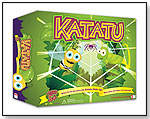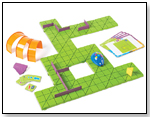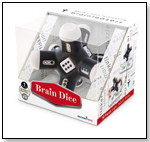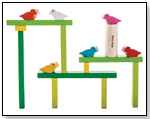|
|
Interview with Curtis Paul, Creator of the Award-Winning KATATU TDmonthly Magazine recently had the chance to interview Curtis Paul, creator of Creative Child Magazine's 2012 Board Game of the Year, KATATU. 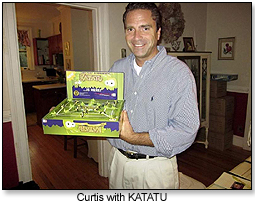 Creating the Game Q. How did you come up with the idea for your award-winning game, KATATU? A. After making my first game (XTREME TAKEOVER ‘Battle of the Xiacons’) I had not only learned a lot, but also had people come out of the wood work with ideas and suggestions for new games. Most of the ideas, I have to admit, are not very good. On a rare occasion someone brings a good (novel) idea, and in the case of KATATU that someone was a girl named Esther from South Africa who introduced me to the ancient game which KATATU takes its roots from. Q. Can you outline the basic concept of the game for our readers? A. It is actually part of our game’s catch phrase: "Where Tic-Tac-Toe leaves off…KATATU picks up"! KATATU is based on getting THREE game pieces (bugs) in a row, or what is called a "KATATU mill," and when you do you can capture one of your opponent’s bugs. The strategy is not only in placing your pieces, but also in deciding which game piece should be captured to better your chances of winning in the end. Q. What elements set this game apart from its competitors? A. In my opinion, there are hardly any well-designed "thinking strategy" games for very small children (ages 4 or 5), and KATATU fills that gap. Many people tell me it’s "essentially" a classic game that is easy to learn and play but hard to master. Because of this, parents and people of all ages enjoy playing it with their kids or with each other. Getting the Game Produced Q. How did you bring the game from the first initial spark of an idea to actual production? A. It was rather quick. I had a prototype in less than a day and it was pretty much designed in my head from the first "spark," or what I call the ‘A-ha moment"… but keep in mind it is just bugs and a game board! What I have learned is that there is beauty in simplicity (less is more), and it makes for a better gaming experience. After prototyping the process slowed, especially working with overseas vendors. It took a little over a year to get to full production. Q. What made working with overseas vendors particularly challenging? Do you have any advice for people just entering the market that could help make this aspect of production go more smoothly? A. The main disconnect is the language barrier, among the other obvious time zone issues. I found that searching for a vendor can be like entering a black hole, and knowing the quality and reputation of the vendor is paramount to the end product. I cannot stress how important understanding this is — if you make a game in today’s market you will have similar challenges! Research, Challenges, and Play Testing A. There were really no major obstacles per se, since I had just published another game and had gone through the difficult process already. Getting the Bugs (game pieces) just right was a little challenging, and there is a magnetic aspect to the game the added another level of complexity in the production. I would also say that I had to do extensive research to ensure that there was nothing else like it on the market, which there was not. Q. How did you research other games on the market to make sure there were none like yours? A. Like most people I checked the Internet first, but I also hired attorneys and researchers to verify my findings. 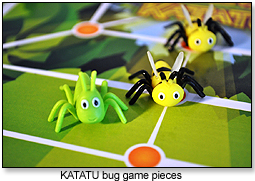 A. With my first game (XTREME TAKEOVER), my box size was too big for the stores to carry, but I really have very little remorse since the game is creative and I have achieved a U.S. Patent for its game play. Q. How did you play test KATATU? A. With anybody and everybody! Testing the game is one of the most important phases of game production, and designers need to listen to the game testers since they are, ultimately, the consumer. I am still tweaking things to make the game even better for future production runs. I do owe a lot of credit to my son who I bothered relentlessly to play the test game. Incidentally, he got so good at KATATU that I have trouble winning against him now! Q. What do you think are the three most important elements of a successful game? You ask this question almost as if I have a world of experience with game designs… so I am flattered (thank you). I am hardly the "Guru" of games, but what I have learned is this:
Q. Have you always been interested in games? Did you ever think you would end up professionally designing games? A. Yes, I have always been interested in toys and games, even designing several games and toys as a young child. I also used to write articles for "Toy Shop" magazine on die cast toy cars (Hot Wheels). Last year I published a book on the History on Hot Wheel Prototypes, so I guess toys are in my nature. Q. What experiences from your adolescence do you think helped prepare you for the business world? A. Everything! Life experiences are cumulative, and all good, bad and indifferent experiences create who we are and what we do. I would like to think that more people should go after their ‘dream’ and worry less about following the path of the masses. Q. What resources would you recommend to someone who wants to get his or her game produced? A. Unfortunately it comes down to money, marketing and whom you know. I see great games and products that individuals have created, but without the proper funding, they go nowhere. On the flip side, I see some less than brilliant products make their way onto store shelves because they have the marketing horse-power and the money to make them successes, despite the fact that children may only play with them once. It is a tough balancing act for a small company with only one or two products to compete with the ‘big boys’, but I continue to work and create with the truth and understanding that the small guy can succeed and possibly and win "Game of the Year," as we did with KATATU!
Xtreme Takeover: Battle of the Xiacons by CURTLIN TOYS AND GAMES LLC  Writer's Bio: Justina Huddleston graduated Magna Cum Laude from Emerson College with a BA in Writing, Literature, and Publishing in 2009. After graduating she was the on-site director of the Boston Children's Museum gift store for a year, selling educational, developmental, and creative activity toys that tied in with the museum's exhibits. Justina also interned at children's book publisher Candlewick Press before moving from Boston to Los Angeles, where she is now Editorial Director of TDmonthly Magazine. Read more articles by this author Writer's Bio: Justina Huddleston graduated Magna Cum Laude from Emerson College with a BA in Writing, Literature, and Publishing in 2009. After graduating she was the on-site director of the Boston Children's Museum gift store for a year, selling educational, developmental, and creative activity toys that tied in with the museum's exhibits. Justina also interned at children's book publisher Candlewick Press before moving from Boston to Los Angeles, where she is now Editorial Director of TDmonthly Magazine. Read more articles by this author |
|
Disclaimer Privacy Policy Career Opportunities
Use of this site constitutes acceptance of our Terms of Use.
© Copyright 2025 PlayZak®, a division of ToyDirectory.com®, Inc.

